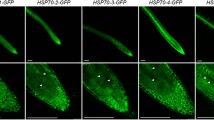Summary
The petumia genome encodes an hsp70 multigene family. Both heat and heavy metals can induce transcription of petunia hsp70 genes. We show that CdCl2 induces at least two family members and that CdCl2 stress, unlike heat stress, interferes with processing of the hsp70 transcripts. We have sequenced a genomic clone corresponding to the sequence of one of the hsp70 cDNAs and found that it contains a 618-bp intron. This intron, which is not efficiently removed during CdCl2 stress, does not appear to encode a novel peptide of any significant length. A preliminary induction of heat shock proteins (hsps) does not protect against the CdCl2 inhibition in Drosophila protects against heat induced inhibition of hsp83 processing (Yost and Lindquist 1986). The mechanism of CdCl2 inhibition of splicing is unclear, however these data support our earlier finding (Rochester et al. 1986) that some stress-inducible plant hsp70 genes, unlike stress-inducible hsp70 genes from other organisms, contain an intron.
Similar content being viewed by others
References
Craig EA (1985) The heat shock response. CRC Crit Rev Biochem 18:239–280
Craig E, Jacobsen K (1985) Mutations of the heat inducible 70 kd genes of yeast confer temperatures sensitive growth. Mol Cell Biol 5:3517–3524
Czarnecka E, Edelman L, Schoffl F, Key JL (1984) Comparative analysis of physical stress responses in soybean seedlings using cloned heat shock cDNAs. Plant Mol Biol 3:45–58
Glass DJ, Polvere RI, VanderPloeg L (1986) Conserved sequences and transcription of the hsp70 gene family in Trypanosoma brucei. Mol Cell Biol 6:4657–4666
Grill E, Winnacker E-L, Zenk MH (1985) Phytochelatins: The principal heavy-metal complexing peptides of higher plants. Science 230:674–676
Grill E, Gekeler W, Winnacker E-L, Zenk HH (1986) Homo-phytochelatins are heavy metal-binding peptides of homo-glutathione containing fabales. FEBS Lett 205:47–50
Gubler U, Hoffman BJ (1983) A simple and very efficient method for generating cDNA libraries. Gene 25:263–269
Hadwiger LA, Schwochau ME (1971) Ultraviolet light induced formation of pisatin and phenylalanine ammonia lyase. Plant Physiol 47:588–590
Henikoff S, Messelson M (1977) Transcription at two heat shock loci in Drosophila. Cell 12:441–451
Kao H-T, Capasso O, Heintz N, Nevins JR (1985) Cell cycle control of the human hsp70 gene: Implications for the role of a cellular EIA-like function. Mol Cell Biol 5:628–633
Kislev N, Rubenstein I (1980) Utility of ethidium bromide in the extraction from whole plants of high molecular weight maize DNA. Plant Physiol 66:1140–1143
Kurtz S, Rossi J, Petko L, Lindquist S (1986) An ancient developmental induction: heat shock proteins induced in sporulation and oogenesis. Science 231:1154–1157
Lemke G, Axel R (1985) Isolation and sequence of a cDNA encoding the major structural protein of peripheral myelin. Cell 40:501–508
Lindquist S (1986) The heat shock response. Annu Rev Biochem 55:1151–1191
Maniatis T, Fritsch EF, Sambrook J (1982) Molecular cloning. A laboratory manual. Cold Spring Harbor Laboratory, Cold Spring Harbor, New York
Okayama H, Berg D (1982) High efficiency cloning of full length complementary DNA. Mol Cell Biol 2:161–170
Palter KB, Watanabe M, Stinson L, Mahowald AP, Craig EA (1986) Expression and localization of Drosophila melanogaster hsp70 cognate proteins. Mol Cell Biol 6:1187–1203
Perrin DR, Cruickshank IAM (1965) Studies on phytoalexins. Aust J Biol Sci 18:803–816
Rochester DE, Winter JA, Shah DM (1986) The structure and expression of maize genes encoding the major heat shock protein, hsp70. EMBO J 5:451–458
Shure M, Fedoroff N, Wessler S (1983) Molecular identification and isolation of the waxy locus in maize. Cell 35:225–233
Sorger PK, Pelham HRB (1987) Cloning and expression of a gene encoding hsc73, the major hsp70-like protein in unstressed rat cells. EMBO J 6:993–998
Wagner GJ, Yeargan R (1986) Variation in cadmium accumulation potential and tissue distribution of cadmium in tobacco. Plant Physiol 82:274–279
Yost HJ, Lindquist S (1986) RNA splicing is interrupted by heat shock and is rescued by heat shock protein synthesis. Cell 45:185–193
Zagursky RJ, Baumeister K, Lomax N, Berman ML (1985) Rapid and easy sequencing of large and linear double-stranded DNA and supercoiled plasmid DNA. Genet Anal Techn 2:89–94
Author information
Authors and Affiliations
Additional information
Communicated by R.B. Goldberg
Rights and permissions
About this article
Cite this article
Winter, J., Wright, R., Duck, N. et al. The inhibition of petunia hsp70 mRNA processing during CdCl2 stress. Mol Gen Genet 211, 315–319 (1988). https://doi.org/10.1007/BF00330609
Received:
Issue Date:
DOI: https://doi.org/10.1007/BF00330609




